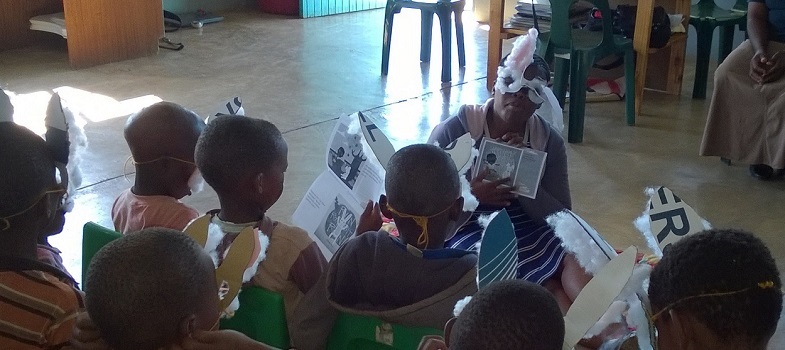Method 3: Language experience approach
The language experience approach focuses on children’s experience and enables them to read about their own lives, in their own words. Skills for reading are based on their knowledge of the language they are using and on their home and community backgrounds, the people they know and the experiences they have. Children work with whole words and sentences rather than letters and parts of words. It allows children to speak before they read and write.
The approach consists of the following four steps:
- Experience: Children do many things at home and at school, usually with other people.
- Description: Children talk about what has happened to them, to each other and/or to the teacher or the class.
- Transcription: Children write about the experiences they have described. Before their writing skills have developed, they can draw or try out writing, or the teacher can write down what they want to say.
- Reading: The children read what they have written to the whole class or to a part of the class.
Read Case Study 4.3 and answer the questions which follow.
Case Study 4.3: Mrs Tekiso uses the language experience approach
Mrs Tekiso is teaching Grade 1 in a school situated in a rural area. The language spoken by her children is Setswana. It is the second half of the school year.
One morning, in the ‘News’ slot of the timetable, Mrs Tekiso asks her children to talk about what they did the day before. Each child is given a chance to talk. She then asks them to draw a picture of what they have told the class and to write a sentence under the picture.
When they have finished, each child shows their picture to their partner and reads the sentence they have written. Then two pairs exchange pictures. Each pair ‘reads’ the two pictures in front of them and the words written on the two pages.
Mrs Tekiso then asks the children to return the pictures to their owners. Each child comes to the front, shows their picture and ‘reads’ their pictures and sentences to the class. The class applauds each child’s work. Without criticising any child’s picture or writing, Mrs Tekiso writes correctly, on the board, the key words that the children have written. She and the class read the words on the board together.
After the lesson, Mrs Tekiso pins the drawings up on the classroom wall. She also puts some of the new words they have used on the word wall.
This case study is also available to download. [Tip: hold Ctrl and click a link to open it in a new tab. (Hide tip)]
Activity 4.4: Thinking about the language experience approach
Having read Case Study 4.3, talk to a colleague or a friend about the following questions. If you have no partner, write your ideas in your study notebook.
- What has this case study shown you about the language experience approach? How does Mrs Tekiso use this method to help the children to read?
- How does the approach ensure that each child is actively involved in the lesson?
- How does the approach ensure that they understand and are interested in what they read?
- How else could Mrs Tekiso enable her children to write down their story?
- Can you think of how else a storybook could be used as a starting point for a lesson using the language experience approach to reading?
Discussion
Here are some ideas we have about ways to help young children to read about their own experiences.
The language experience approach ensures that each child is actively involved by letting them write and read about their own experience. This also means that they are interested in what they are doing and understand what they have written and read.
Instead of letting them try to write their own words, Mrs Tekiso could have gone round the class asking them which word they wanted to write. She could then have written it herself at the bottom of the page. The children would then have read the word to their partner and to the whole class.
If Mrs Tekiso had wanted to use a storybook in the language experience approach, she could have read the story to the children and asked them what they thought of it, or whether they had ever experienced something similar. For example:
- If the story is about fruit (for example, Punishment), she can ask the children about their favourite fruit. They could then draw the fruit and write its name. Alternatively, she could write the fruit’s name for them. They would then have a chance to read the word.
- If the story is about somebody who made a mistake and learned a lesson (such as Chicken and Millipede), children can talk about a time when they made a mistake and learned a lesson. If the children are a bit older, they can write a sentence or two about what happened to them and read it to the class.
How would you use the language experience approach? You will have a chance to think about this in Activity 4.5.
Activity 4.5: Using the language experience approach
Plan a lesson like Mrs Tekiso’s in your study notebook. If you have the chance, try it out in your class, or with a group of neighbours’ children, colleagues or friends. You might want to use one of the approaches in the discussion section of Activity 4.4 instead of following Mrs Tekiso’s plan exactly.
Method 2: Look-and-say



